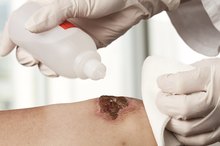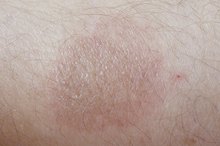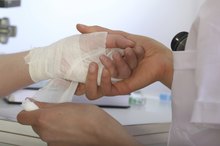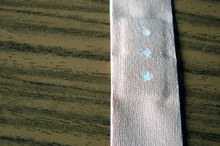How to Treat a Blistering Burn on Finger
Your fingers are vulnerable to burns because of their nearly constant use as you go about your daily life. Accidental contact with something hot, like a flame, hot burner, scalding water or steam, frequently results in finger burns.
Burns that blister are second-degree burns, also known as partial-thickness burns. These burns involve both the top and middle layers of the skin. Second-degree burns are further categorized into superficial and deep partial-thickness burns.
These burns typically appear red, characteristically blister and are quite painful. Second-degree burns involving one or more fingers require immediate first aid at home and followup the same day with your healthcare provider for evaluation and treatment.
Stop the Burning Process
Stopping the burning process is the first step in treating any burn. With finger burns, this can be easily accomplished by putting your hand under the faucet and gently running cool (not cold) water over the burned area. **Keep your hand under the running water for 20 minutes.
If you've sustained a chemical burn, you may need to continue to keep your hand under the running water for a longer period to ensure the chemical is completely rinsed away. Check with your local poison control center or call 911. **
If you're wearing a ring on the burned hand, gently remove it -- if possible -- while your hand is under the cool running water.
This will prevent the ring from getting stuck on your finger as the burned area is likely to swell. Do not apply ice, ice water or anything frozen on the area as this could further damage the burned tissue.
- Stopping the burning process is the first step in treating any burn.
- If you're wearing a ring on the burned hand, gently remove it -- if possible -- while your hand is under the cool running water.
Cover the Burn
How to Treat Burns Caused by Boiling Water
Learn More
Allow your hand to air dry. If you have plastic wrap (such as used for food storage), pull the first 4 to 6 inches off the roll and throw it away.
Then pull an appropriate length of plastic wrap from the roll and wrap it loosely around your burned finger(s). If you don't have plastic wrap, you can place your entire hand in a large, new food storage bag and loosely secure it in place at your wrist with a short piece of adhesive tape. The plastic wrap or bag will protect the burn without sticking to it until you see a doctor.
- Allow your hand to air dry.
- If you have plastic wrap (such as used for food storage), pull the first 4 to 6 inches off the roll and throw it away.
Seek Medical Evaluation and Care
Second-degree burns of the fingers vary in severity and are treated differently, depending on factors such as the depth and size of the burn, and the exact location. Additionally, more serious second-degree burns can progress to third-degree burns after the initial injury.
For these reasons, it's critical to seek professional medical evaluation and treatment without delay -- always on the same day as the injury -- if you sustain a second-degree burn to your finger(s) or hand. If you cannot reach your doctor, seek medical care at the nearest urgent or emergency care facility.
An over-the-counter pain reliever such as acetaminophen (Tylenol) or ibuprofen (Advil, Motrin) might help control your discomfort until you're seen by a healthcare provider.
- Second-degree burns of the fingers vary in severity and are treated differently, depending on factors such as the depth and size of the burn, and the exact location.
- For these reasons, it's critical to seek professional medical evaluation and treatment without delay -- always on the same day as the injury -- if you sustain a second-degree burn to your finger(s) or hand.
Treatment and Healing
How to Treat a Burn on the Fingers
Learn More
Treatment of second-degree burns involving the fingers focuses on preventing infection, promoting healing, limiting scarring and retaining mobility of the finger(s). Special types of wound bandages and topical antibiotics are typically part of the treatment plan. Deep, partial-thickness burns of the fingers sometimes require more involved treatment, which may include surgery and/or hand therapy 56.
Superficial partial-thickness burns of the fingers usually heal within approximately 3 weeks. Deep partial-thickness burns take longer to heal, often 6 weeks or longer.
- Treatment of second-degree burns involving the fingers focuses on preventing infection, promoting healing, limiting scarring and retaining mobility of the finger(s).
- Deep, partial-thickness burns of the fingers sometimes require more involved treatment, which may include surgery and/or hand therapy 5.
Warnings and Precautions
Do not attempt to treat a second-degree burn involving one or more fingers on your own. This is especially important for children and people with diabetes, poor circulation and/or a weakened immune system.
Seek emergency medical care for a chemical or electrical burn, regardless of the presence or absence of blistering.
Carefully follow all burn care instructions recommended by your healthcare provider. Be sure to ask when to call if something is not going as expected with your treatment.
Reviewed and revised by: Tina M. St. John, M.D.
- Do not attempt to treat a second-degree burn involving one or more fingers on your own.
- Be sure to ask when to call if something is not going as expected with your treatment.
Related Articles
References
- Principles of Hand Surgery and Therapy, 3rd Edition; Thomas E. Trumble, et al.
- Clinical Advisor: When to Treat or Refer a Burn-Injured Patient
- Wheeless’ Textbook of Orthopaedics: Burns of the Hand
- Practical Plastic Surgery: Hand Burns
- Wounds: Management of Burns to the Hand
- Knowlin, L., Stanford, L., Moore, D., Cairns, B., & Charles, A. (2016). The Measured Effect Magnitude of Co-Morbidities on Burn injury Mortality. Burns : Journal of the International Society for Burn Injuries, 42(7), 1433–1438. http://doi.org/10.1016/j.burns.2016.03.007
- Hilton G. Thermal Burns: The ABCs are crucial, since the major threat is often inhalation injury. Am J Nurs. 2001;101(11):32-34. doi:10.1097/00000446-200111000-00017
- Cleveland Clinic. Burns. Updated August 31, 2017.
- Thom D. Appraising current methods for preclinical calculation of burn size - A pre-hospital perspective. Burns. 2017;43(1):127-136. doi: 10.1016/j.burns.2016.07.003.
- Knowlin, L., Stanford, L., Moore, D., Cairns, B., & Charles, A. (2016). The Measured Effect Magnitude of Co-Morbidities on Burn injury Mortality. Burns : Journal of the International Society for Burn Injuries, 42(7), 1433–1438.
Writer Bio
Kathryn Meininger began writing and publishing poetry in 1967. She was co-founder and editor of the professional magazine "Footsteps" and began writing articles online in 2010. She earned a Doctor of Podiatric Medicine from Temple University School of Podiatric Medicine and a Bachelor of Arts in biology from William Paterson University.







